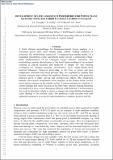| dc.contributor.author | Farragher, Tadhg P. | |
| dc.contributor.author | Leen, Sean B. | |
| dc.date.accessioned | 2015-12-17T10:07:27Z | |
| dc.date.available | 2015-12-17T10:07:27Z | |
| dc.date.issued | 2013-12-22 | |
| dc.identifier.citation | Farragher, TP, Scully, S, O Dowd, NP, Leen, SB (2013) 'Development of life assessment procedures for power plant headers operated under flexible loading scenarios'. International Journal Of Fatigue, 49 :50-61. | en_IE |
| dc.identifier.issn | 0142-1123 | |
| dc.identifier.uri | http://hdl.handle.net/10379/5409 | |
| dc.description | Journal article | en_IE |
| dc.description.abstract | A finite element methodology for thermo-mechanical fatigue analysis of a subcritical power plant outlet header under realistic loading conditions is presented. The methodology consists of (i) a transient heat transfer model, (ii) a sequential anisothermal cyclic viscoplastic model and (iii) a multiaxial, critical-plane implementation of the Ostergren fatigue indicator parameter. The methodology permits identification of the local thermo-mechanical stress–strain response at critical locations and prediction of fatigue life and cracking orientation for complex transient, anisothermal, cyclic elastic–plastic-creep material behaviour. Measured plant data, in the form of steam and pipe temperature transients and steam pressure data, are employed to identify heat transfer constants and validate the predicted thermal response, with particular attention given to plant start-up and attemperation effects. The predictions indicate out-of-phase temperature-strain response at the header inside surface and in-phase response on the outside surface. Cooling transients are predicted to control damage and crack initiation at the inner bore, whereas heating transients are predicted to have a more damaging effect at weld locations. A representative test cycle is presented, which is shown to capture the salient thermo-mechanical cyclic damage of the realistic cycle. The predicted results correlate well with industrial experience in terms of crack (initiation) orientation, location and life. | en_IE |
| dc.description.sponsorship | Science Foundation Ireland - SFI/10/IN.1/I3015 | en_IE |
| dc.format | application/pdf | en_IE |
| dc.language.iso | en | en_IE |
| dc.publisher | Elsevier ScienceDirect | en_IE |
| dc.relation.ispartof | International Journal Of Fatigue | en |
| dc.rights | Attribution-NonCommercial-NoDerivs 3.0 Ireland | |
| dc.rights.uri | https://creativecommons.org/licenses/by-nc-nd/3.0/ie/ | |
| dc.subject | Thermo-mechanical fatigue | en_IE |
| dc.subject | High temperature viscoplasicity | en_IE |
| dc.subject | Flexible plant operation | en_IE |
| dc.subject | Critical-plane Ostegren | en_IE |
| dc.subject | Complex geometry | en_IE |
| dc.subject | Sub-modelling | en_IE |
| dc.subject | Finite element | en_IE |
| dc.title | Development of life assessment procedures for power plant headers operated under flexible loading scenarios | en_IE |
| dc.type | Article | en_IE |
| dc.date.updated | 2015-12-07T12:57:10Z | |
| dc.identifier.doi | 10.1016/j.ijfatigue.2012.12.007 | |
| dc.local.publishedsource | http://dx.doi.org/10.1016/j.ijfatigue.2012.12.007 | en_IE |
| dc.description.peer-reviewed | peer-reviewed | |
| dc.contributor.funder | |~| | |
| dc.internal.rssid | 10125586 | |
| dc.local.contact | Sean Leen, Mechanical & Biomedical Eng, Eng-2051, New Engineering Building, Nui Galway. 5955 Email: sean.leen@nuigalway.ie | |
| dc.local.copyrightchecked | Yes | |
| dc.local.version | PUBLISHED | |
| nui.item.downloads | 767 | |


